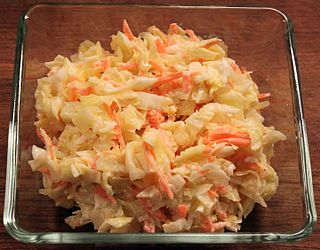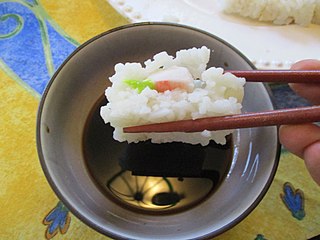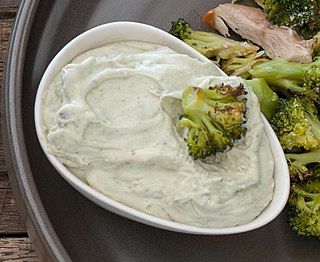
Mayonnaise, colloquially referred to as "mayo", is a thick, cold, and creamy sauce commonly used on sandwiches, hamburgers, composed salads, and French fries. It also forms the base for various other sauces, such as tartar sauce, fry sauce, remoulade, salsa golf, ranch dressing, and rouille.

A salad dressing is a sauce for salads. Used on virtually all leafy salads, dressings may also be used in making salads of beans, noodle or pasta salads and antipasti, and forms of potato salad.

Fry sauce is a condiment often served with French fries or tostones in many places in the world. It is usually a combination of one part tomato ketchup and two parts mayonnaise.

Green sauce or greensauce is a family of cold, uncooked sauces based on chopped herbs, including the Spanish and Italian salsa verde, the French sauce verte, the German grüne Soße or Frankfurter grie Soß, the British mint sauce and greensauce, and the Argentinian chimichurri.

Coleslaw, also known as cole slaw, or simply as slaw, is a side dish consisting primarily of finely shredded raw cabbage with a salad dressing or condiment, commonly either vinaigrette or mayonnaise. This dish originated in the Netherlands in the 18th century. Coleslaw prepared with vinaigrette may benefit from the long lifespan granted by pickling.

Rémoulade is a cold sauce. Although similar to tartar sauce, it is often more yellowish, sometimes flavored with curry, and often contains chopped pickles or piccalilli. It can also contain horseradish, paprika, anchovies, capers and a host of other items.

A dip or dip sauce is a common condiment for many types of food. Dips are used to add flavor or texture to a food, such as pita bread, dumplings, crackers, chopped raw vegetables, fruits, seafood, cubed pieces of meat and cheese, potato chips, tortilla chips, falafel, and sometimes even whole sandwiches in the case of jus. Unlike other sauces, instead of applying the sauce to the food, the food is typically placed or dipped into the sauce.

Miracle Whip is a condiment manufactured by Kraft Heinz and sold throughout the United States and Canada. It is also sold by Mondelēz International as "Miracel Whip" throughout Germany. It was developed as a less expensive alternative to mayonnaise in 1933.

Blue cheese dressing is a popular side sauce, salad dressing and dip in the United States and Canada. It is usually made of some combination of blue cheese, mayonnaise, and buttermilk, sour cream or yogurt, milk, vinegar, onion powder, and garlic powder. There is a blue cheese vinaigrette that consists of salad oil, blue cheese, vinegar, and sometimes seasonings.

Green goddess is a salad dressing, typically containing mayonnaise, sour cream, chervil, chives, anchovy, tarragon, lemon juice, and pepper.

Heinz Tomato Ketchup is a brand of ketchup manufactured by the H. J. Heinz Company, a division of the Kraft Heinz Company.

The McDonald's Premium line is a group of products introduced by McDonald's in the spring of 2003. It includes the company's larger chicken sandwiches, its salad line, and its coffee products. The sandwiches are targeted at various demographic markets, the grilled chicken sandwiches and salads are targeted at both the female and health-conscious demographic markets. The entire line is intended to bring in a larger, more affluent, adult audience seeking better quality products.

Lady's Choice is a spread and salad dressing condiment brand owned by Unilever. The brand was introduced in 1955 by California Manufacturing Company (CMC).














